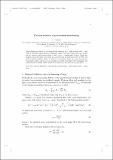The new frontiers of gravitational microlensing
Abstract
Albert Einstein referred to gravitational microlensing as a “most curious effect”, and while its underlying principles are intriguingly simple, their universality makes a powerful tool for inferring information about a wide range of astronomical bodies. Much has happened since the first observation of a gravitational microlensing event in 1992, and the frontiers have shifted. What we did not dare dreaming about just a few decades ago turned into reality, and we have not reached the end of the journey. New challenges and opportunities lie ahead. Where might we be able to go and how can we get there?
Citation
Dominik , M 2022 , ' The new frontiers of gravitational microlensing ' , International Journal of Modern Physics D , vol. 31 , no. 11 , 2240009 . https://doi.org/10.1142/s0218271822400090
Publication
International Journal of Modern Physics D
Status
Peer reviewed
ISSN
0218-2718Type
Journal article
Collections
Items in the St Andrews Research Repository are protected by copyright, with all rights reserved, unless otherwise indicated.

